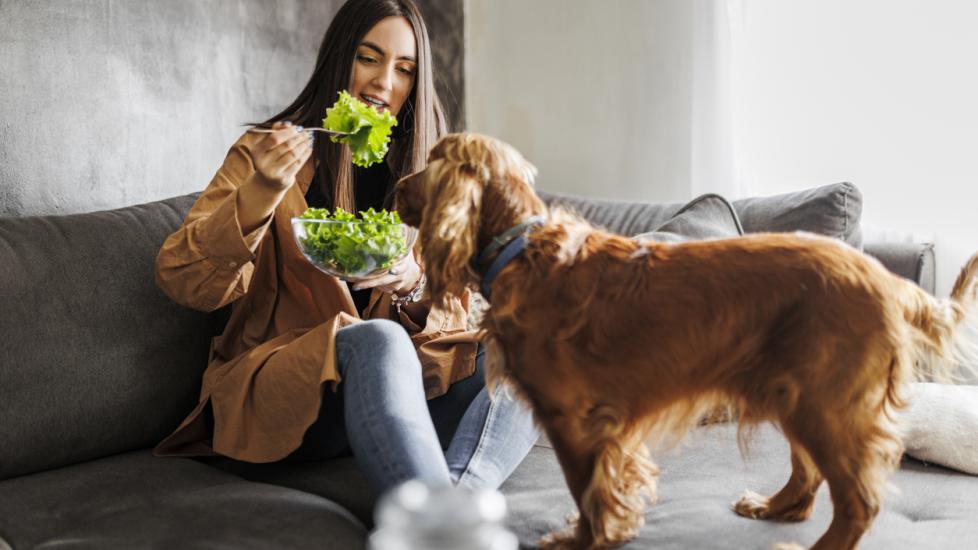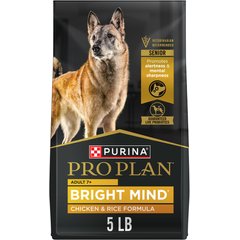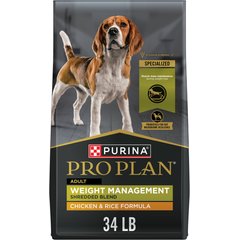Can Dogs Eat Lettuce?
NOTE: Always check with your veterinarian first before giving your dog any new foods, especially “people foods.” What might be OK for one dog might not be good for your dog, depending on multiple factors, such as their age, health history, health conditions, and diet. Dogs on prescription diets should not be fed any food or treats outside the diet.
Though it’s a diet staple for rabbits, occasionally your dog may want a bite of your salad. Or maybe you’ve got a hound who gets into everything, and she ends up munching on a mouthful of lettuce. Whether it’s romaine, iceberg, or salad mix, generally speaking it’s OK for your pup to eat plain lettuce, since it’s not toxic or harmful for dogs.
But there are a few precautions you should know before you add lettuce to your dog’s dinner bowl. A nice green salad is a healthy option for humans, but a wedge salad covered in creamy bleu cheese dressing and bacon is not a good idea for your pet.
Is Lettuce Good for Dogs?
Lettuce can be a good source of vitamins A and K, as well as some minerals like potassium. But lettuce is mostly made up of water and fiber, and it’s low in calories and protein. Dogs require a balanced, nutrient-dense diet—so unless your pooch needs to limit her calorie intake for health reasons, feeding your dog a bunch of lettuce won’t do much for her that supplements couldn’t do better.
If your vet does recommend that your dog shed a few pounds, adding lettuce or other low-calorie foods to your dog’s bowl in place of other high-calorie ingredients may help her lose weight. Because lettuce is 90% water, adding this fiber-rich, crunchy plant to her diet may help her feel full for longer and aid in weight loss.
Keep in mind that not all lettuce is created equally. Iceberg is “the least nutrient-dense salad green,” according to Harvard Health Publishing. Spinach, kale, and romaine are considered more nutritious greens and offer a healthy combo of vitamins A, C, and K; several types of B vitamins; and potassium. If your pooch is lacking any of those nutrients, mixing small amounts of lettuce into her food bowl may help her get more vitamins. But lettuce should only be a complement to your dog’s regular diet, not a substitute for their meals, as dogs need protein and fat to survive.
Be sure to talk with a vet before making any changes to your dog's diet, especially if your hound has any health conditions.
Vet Recommended Dog Food
- Eukanuba Premium Performance Puppy Pro Dry Dog Food, 4-lb bag$25.99Chewy Price
- Purina Pro Plan Bright Mind Adult 7+ Chicken & Rice Formula Dry Dog Food, 5-lb bag$19.74Chewy Price
- Purina Pro Plan Adult Weight Management Shredded Blend Chicken & Rice Formula Dry Dog Food, 34-lb bag$71.98Chewy Price
- Hill's Science Diet Adult Lamb Meal & Brown Rice Recipe Dry Dog Food, 33-lb bag$83.99Chewy Price
Can Lettuce Be Bad for Dogs?
While lettuce is a healthy choice for humans, the veggie alone does not have enough nutrients to replace a full meal. The same rule applies to dogs. Our canine friends need fat and protein, so even though lettuce is a safe vegetable for them to eat, it’s mostly water and fiber. Too much can cause diarrhea or an upset stomach.
Also, be sure to thoroughly wash lettuce before feeding it to your dog (or yourself, for that matter). Washing your lettuce can help remove pesticides lingering from the farm, as well as remove any listeria or E. coli bacteria.
How Much Lettuce Can Your Dog Eat?
While lettuce can be a healthy addition to your dog’s balanced diet, start slowly and check with your vet first. It’s probably not a good idea to add an entire head of lettuce to your pet’s bowl at dinnertime, but offering her an occasional crunchy leaf or two while you make your own salad is OK.
Here are some general guidelines for how much lettuce is safe for dogs to eat, based on their weight:
-
Extra-small dog (2–20 pounds): 1/4 cup of washed, chopped lettuce per day
-
Examples: Yorkies, Chihuahuas, Pomeranians, Pugs
-
-
Small dog (21–30 pounds): 1/2 cup of washed, chopped lettuce per day
-
Examples: Basenjis, Beagles, Scottish Terriers
-
-
Medium dogs (31–50 pounds): 1 cup of washed, chopped lettuce per day
-
Examples: Basset Hounds, Border Collies, Australian Cattle Dogs
-
-
Large dogs (51–90 pounds): 2 cups of washed, chopped lettuce per day
-
Examples: Pit Bulls, German Shepherds, Labrador Retrievers, Australian Shepherds
-
-
Extra-large dogs (over 90 pounds): 2 ¼ cups of washed, chopped lettuce per day
-
Examples: Newfoundlands, Bernese Mountain Dogs, St. Bernards, Great Pyrenees
-
Can Dogs Eat Salad?
Salad may be a healthy choice for humans, but it’s not so great for dogs. Common salad ingredients, like onions or dairy, can be harmful for dogs to eat. Salad dressing can also be problematic, since creamy ones like ranch, Caesar, and bleu cheese are high in fat. Fatty foods can cause pancreatitis in dogs, which is a painful condition that requires treatment from a vet.
While salad and all the fixings are not safe for your pet to eat, there are several common salad vegetables that are OK to feed to dogs plain:
-
Carrots: A good source of vitamins A, K, and C. They’re also high potassium and low in calories.
-
Tomatoes: Contain vitamins A and C. Just keep in mind that some dogs may be sensitive to tomatoes in large quantities, so only feed in moderation.
-
Cucumbers: Another mostly water vegetable, cucumbers help with hydration and are low in calories.
-
Bell peppers: Contain vitamins A and C, as well as potassium.
-
Spinach: A good source of vitamins A, K, and C, as well as potassium.
-
Broccoli: This little snack is a good source of vitamins A, C, and K, as well as potassium and fiber. Just watch out for gas!
Not all vegetables are safe for dogs to eat. Some veggies, such as onions, garlic, and chives, are toxic to dogs and should be avoided. You should always talk to your vet before introducing new foods to your dog's diet.
How to Feed Your Dog Lettuce
It’s certainly not as tempting to a dog as a piece of chicken or lick of peanut butter, so you may need to mix in lettuce with other food to get your pup to eat her serving of veggies.
First, wash all greens thoroughly to remove any residual pesticides or chemicals. Next, chop or tear into small pieces. Then you can mix the chopped lettuce into her usual dog food or use it as a food topper. If she’s willing to eat it plain, try offering it as a treat … but good luck!
No matter how you add lettuce to her diet, be sure to start with small amounts so her body can adjust to this new fiber-forward ingredient and watch for any adverse reactions.
What Other Greens Can Dogs Eat?
If you need to increase your dog’s intake of vegetables or fiber, there are several other leafy greens that are safe for dogs to eat in addition to lettuce. But consider yourself warned—some of these fiber-rich veggies can also cause increased flatulence. Moderation is key!
-
Romaine
-
Cabbage
-
Broccoli
-
Spinach (dogs with kidney issues should avoid this, as it’s high in oxalates)
-
Kale (while generally considered safe, this is another green that dogs with kidney issues should avoid)
Keep in mind that these are just general guidelines. It’s always best to check with your vet before making changes to your dog’s diet.
Featured Image: iStock/Eleganza




